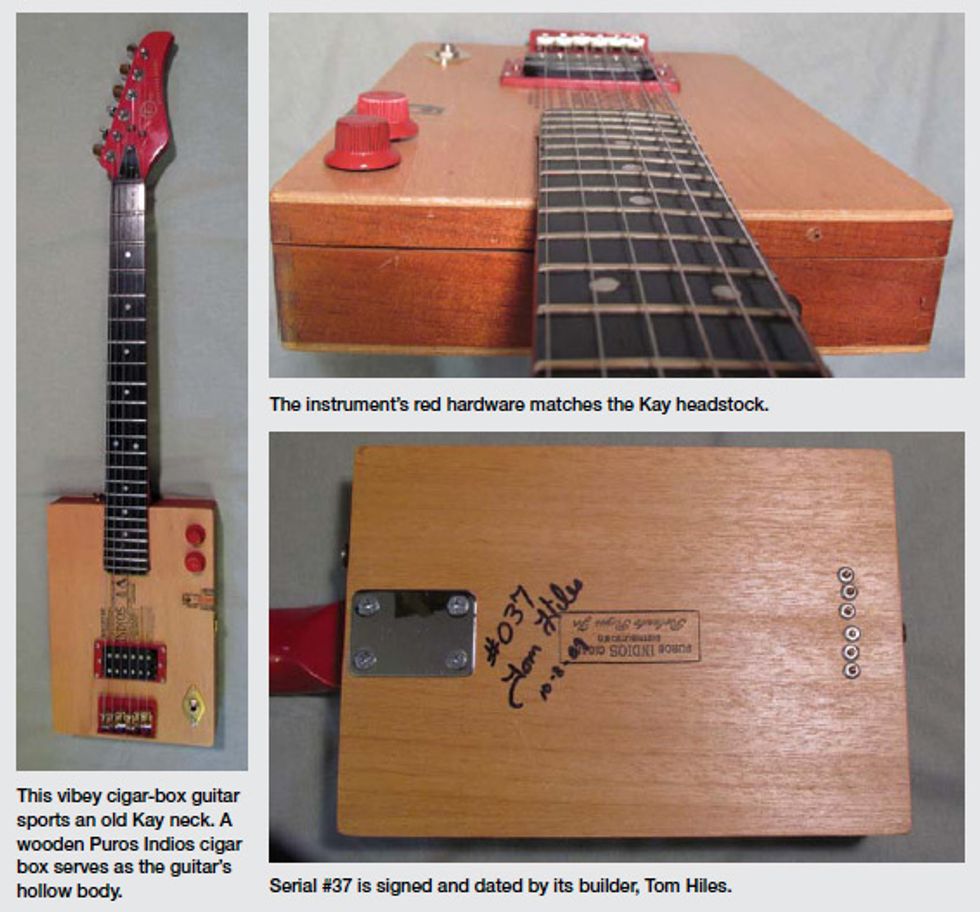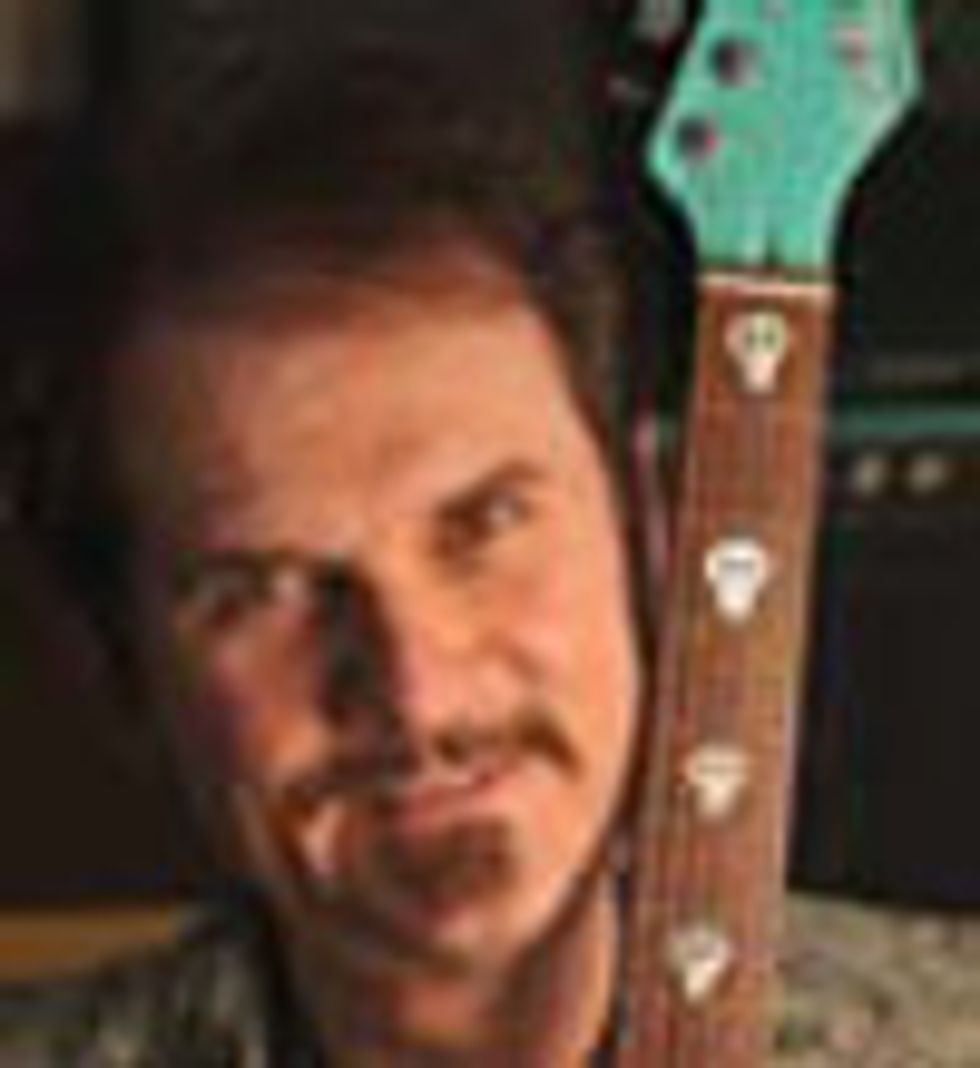For inexplicable reasons, I’ve
been bitten by the cigar-box
guitar bug. At present, I own
eight CBGs and counting. It all
started when I was doing my
daily search on eBay for Kay
guitars, and this baby showed
up. It was a totally playable guitar
made out of a cigar box and
some extra guitar parts, including
a bolt-on neck off an old
Kay solidbody. I was intrigued
by how the builder had spray-painted
some of the hardware red
to match the Kay’s headstock.
Pretty crafty!

So I bookmarked the auction and checked on its status each day until—after repeated viewings—I knew I just had to have it. So I sniped in the last few seconds and snagged it for $107 plus $25 shipping. When the guitar arrived, I just marveled at its construction: It had a Strat-style bridge with six individually adjustable saddles, a humbucking pickup, Volume and Tone controls, and a jack mounted on the face of a wooden Puros Indios cigar box. How cool is that?
The action was kind of high for my taste, so first I adjusted the truss rod. Removing excess relief lowered the action a bit, but not enough. I could have lowered the bridge saddles, but then they would have been very near the end of their downward adjustment range. Instead, I decided to shim the neck and thus preserve some latitude for lowering the saddles in the future.
Bottom Feeder Tip #2287: When you need to significantly lower the action on a bolt-on neck, never be afraid to use a shim. It’s a quick and easy way to realign the neck angle to keep your action low and the playability factor high. When shimming a neck, I first loosen the strings, place a capo on the neck around the 12th or 14th fret to keep the strings in place, and then carefully unscrew the neck bolts and remove the neck.
If I wish to raise the fretboard towards the strings to lower the action, I’ll place a thin piece of cardboard about 2" x 3/4" long in the furthest end of the neck pocket towards the bridge. (Conversely, if I want to raise the action, I’ll position the shim towards the headstock side of the neck pocket. This tilts the end of the fretboard down, dropping it away from the strings.) Note: A little bit of shimming goes a long way, so use a thin shim at first to see how much it changes the neck pitch. Cereal-box cardboard is about the thickness I prefer to start with.
When you’re done shimming, gently put the neck back into the neck pocket, being careful not to accidentally skew the shim. Then fully tighten the bolts, tune the guitar up to pitch, remove the capo and see how your action is. If it’s relatively close, go ahead and use the height-adjustment screws on the saddles to fine-tune the action. If the action needs more adjusting, fiddle around with different size shims until you get it where you want it.
So how is the CBG now? Great! The action is nice and low, it’s fun to play, and it always turns heads whenever I bring it out. The fellow who made it, Tom Hiles, lives in South Dakota and has built many CBGs (mine is serial #37). I was so impressed with his workmanship that I eventually had him build another CBG that incorporated some old Fender Will Ray signature-model guitar parts I had lying around. I got to know him pretty well and later recorded a YouTube video of me playing one of his CBGs in hopes of turning more people on to his work.
CBGs are not hard to make if you’re adventurous, and there are many kits available. Bottom Feeder Tip #267: Always make friends with gifted craftsmen you run across, because you never know when you may want to use their expertise. This CBG is part of my arsenal now, and I look forward to getting more of these instruments down the road. They are fully functional guitars, very light, sound great, and are supremely fun to play. This one’s definitely a keeper.
 Will Ray
is a founding
member of the
Hellecasters guitar-twang
trio. He also does guitar
clinics promoting his
namesake G&L signature
model 6-string, and produces
artists and bands at his studio in
Asheville, North Carolina. You can contact
Will on Facebook and at willray.biz.
Will Ray
is a founding
member of the
Hellecasters guitar-twang
trio. He also does guitar
clinics promoting his
namesake G&L signature
model 6-string, and produces
artists and bands at his studio in
Asheville, North Carolina. You can contact
Will on Facebook and at willray.biz.






![Rig Rundown: Russian Circles’ Mike Sullivan [2025]](https://www.premierguitar.com/media-library/youtube.jpg?id=62303631&width=1245&height=700&quality=70&coordinates=0%2C0%2C0%2C0)

















